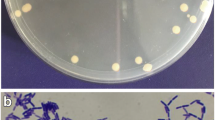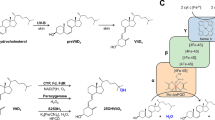Abstract
To enzymatically synthesize active metabolites of vitamin D3, we screened about 500 bacterial strains and 450 fungal strains, of which 12 strains were able to convert vitamin D3 to 1α,25-dihydroxyvitamin D3 [1α,25(OH)2D3] via 25-hyroxyvitamin D3 [25(OH)D3]. The conversion activity was only detected in strains belonging to the genus Amycolata among all the organisms tested. A preparative-scale conversion of vitamin D3 to 25(OH)D3 and 1α,25(OH)2D3 in a 200-1 tank fermentor using A. autotrophica FERM BP-1573 was accomplished, yielding 8.3 mg 25(OH)D3/l culture and 0.17 mg 1α,25(OH)2D3/l culture. A related compound, vitamin D2, could be also converted to 25-hydroxyvitamin D2 and 1α,25-dihydroxyvitamin D2 using the same strain. The cytochrome P-450 of FERM BP-1573 was detected by reduced CO difference spectra in whole-cell suspensions. Vitamin D3 in the culture induced cytochrome P-450 and the conversion activity simultaneously, suggesting that the hydroxylation at C-25 of vitamin D3 and at C-1 of 25(OH)D3 originates from cytochrome P-450.
Similar content being viewed by others
References
DeLuca HF, Schnoes HK (1983) Vitamin D, recent advances. Annu Rev Biochem 52:411–439
Fujii T, Ogawa T, Fukuda H (1989) The relationship between isobutene-forming activity and cytochrome P-450 in Rhodotorula minuta, J Ferment Bioeng 68:174–177
Gray RW, Omdahl JL, Ghazarian JG, DeLuca HF (1972) 25-hydroxycholecalciferol-1-hydroxylase. Subcellular location and properties. J Biol Chem 247:7528–7532
Hansson R, Holmberg I, Wikvall K (1981) 25-Hydroxylation of vitamin D3 and side-chain hydroxylation of 5β-cholestane-3α, 7α,12α-triol by purified rabbit and rat liver microsomal cytochrome P-450. J Biol Chem 256:4345–4349
Hiwatashi A, Ichikawa Y (1980) Purification and organ-specific properties of the cholecalciferol system, Cytochrome P-450 d25-l linked mixed function oxidase system. Biochem Biophys Res Commun 97:1443–1449
Hiwatashi A, Nishii Y, Ichikawa Y (1982) Purification of cytochrome P-450 d1 (25-hydroxyvitamin D3-1α-hydroxylase) of bovine kidney mitochondria. Biochem Biophys Res Commun 105:320–327
Ikekawa N (1987) Structures and biological activities of vitamin D and their analogs. Med Res Rev 7:333–366
Kametani A, Furuyama H (1987) Synthesis of vitamin D3 and related compounds. Med Res Rev 7:147–171
Lechevalier MP, Prauser H, Labeda DP, Ruan JS (1986) Two new genera of nocardioform actinomycetes: Amycolata gen. nov. and Amycolatopsis gen. nov. 36:29–37
Lowry OH, Rosebrough NJ, Farr AL, Randall RJ (1951) Protein measurement with the Folin-phenol reagent. J Biol Chem 193:265–275
Lund J, DeLuca HF (1966) Biologically active metabolite of vitamin D3 from bone, liver, and blood serum. J Lipid Res 7:739–744
Madhok TC, DeLuca HF (1979) Characteristics of the rat liver microsomal enzyme system converting cholecalciferol into 25-hydroxycholecalciferol. Biochem J 184:491–499
Miwa I, Okuda J, Maeda K, Okuda G (1972) Mutarotase effect on colorimetric determination of blood glucose with β-d-glucose oxidase. Clin Chim Acta 37:538–540
Mundy GR, Roodman GD (1987) Osteoclast ontogeny and function. Bone Miner Res 5:209–278
Okazaki T, Serizawa N, Enokita R, Torikata A, Terahara A (1983) Taxonomy of actinomycetes capable of hydroxylation of ML-236B (compactin). J Antibiot 36:1176–1183
Omura S, Sasaki J, Mikami A, Mizoue K (1990a) Method for preparing vitamin D compounds. US patent no 4,892,821
Omura S, Sasaki J, Mikami A, Mizoue K (99b) Method for preparing vitamin D compounds. Japanese patent no. 2-231089
Omura S, Sato R (1964) The carbon-monoxide-binding pigment of liver microsomes. J Biol Chem 239:2370–2378
Rosazza JP, Smith RV (1979) Microbial models for drug metabolism. Adv Appl Microbiol 25:169–208
Sasaki J, Mikami A, Mizoue K, Omura S (1991) Transformation of 25- and 1α-hydroxyvitamin D3 to 1α,25-dihydroxyvitamin D3 by using Streptomyces sp. strains. Appl Environ Microbiol 57:2841–2846
Seino Y, Tanaka H, Yamaoka K, Yabuuchi H (1987) Circulating 1α,25-dihydroxyvitamin D levels after a single dose of 1α,25-dihydroxyvitamin D3 or 1α-hydroxyvitamin D3 in normal men. Bone Miner 2:479–485
Seino Y, Yamaoka K, Ichida M, Yabuuich H, Ishikawa M, Ishige H, Yoshino H, Avioli LV (1982) Biochemical characterization of 1α,25(OH)2D3 receptor in chick embryonal duodenal cytosol. Calcif Tissue Int 34:265–269
Author information
Authors and Affiliations
Additional information
Correspondence to: J. Sasaki
Rights and permissions
About this article
Cite this article
Sasaki, J., Miyazaki, A., Saito, M. et al. Transformation of vitamin D3 to 1α,25-dihydroxyvitamin D3 via 25-hydroxyvitamin D3 using Amycolata sp. strains. Appl Microbiol Biotechnol 38, 152–157 (1992). https://doi.org/10.1007/BF00174460
Received:
Accepted:
Issue Date:
DOI: https://doi.org/10.1007/BF00174460




